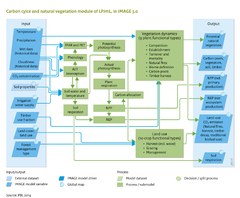Carbon cycle and natural vegetation/Data uncertainties limitations
Parts of Carbon cycle and natural vegetation/Data uncertainties limitations
| Component is implemented in: |
|
| Related IMAGE components |
| Models/Databases |
| Key publications |
| References |
Data, uncertainty and limitations
Data
The LPJmL model uses the FAO harmonised world soil map, to provide information on soil texture and hydraulic properties (FAO et al., 2009). Climate input data come from the IMAGE climate model. Comparison of carbon stocks and fluxes with IPCC estimates shows these estimates are well within the uncertainty range. The modelled distribution of plant functional types has been found to compare well to other data sources.
Uncertainties
Although the terrestrial biosphere plays a key role in the global carbon cycle, it is also subject to considerable uncertainty. Current carbon fluxes are highly uncertain because they cannot be observed directly on a large scale, and vary considerably in time and space. Thus, all available estimates of global carbon pools and fluxes are model-based.
For the future dynamics of the terrestrial carbon cycle, additional uncertainty arises from physiological and ecological processes and interactions, which change rapidly under changing environmental conditions. As a dynamic global vegetation model, LPJmL can simulate carbon dynamics under internally computed vegetation shifts that occur in response to climate change, the impacts of land-use change, water availability and CO2 fertilisation (Heyder et al., 2011). The most uncertain parameters in future dynamics are the combined effect of temperature and precipitation change on soil respiration, and the effect of CO2 fertilisation. An uncertainty range for how the terrestrial biosphere may react to climate change scenarios is presented above.
Limitations
Permafrost modules have been developed to improve assessment of future climate change impacts on the carbon balance (Schaphoff et al., 2013). Impacts of weather extremes can be assessed, provided they are represented in the climate input data (e.g., heat waves, dry spells). However, only few data are available on the effects of weather extremes on the carbon balance to enable evaluation of the model’s capability in this respect. Simulation results from LPJmL calculation are within current estimates (Vetter et al., 2008). A key limitation of LPJmL 4.0 which is part of IMAGE 3.2 is that it does not yet include nutrient flows, specifically nitrogen. A recent LPJmL version does include the nitrogen which substantially improves crop yield estimates especially in relation to CO2 fertilisation (von Bloh et al., 2018).
